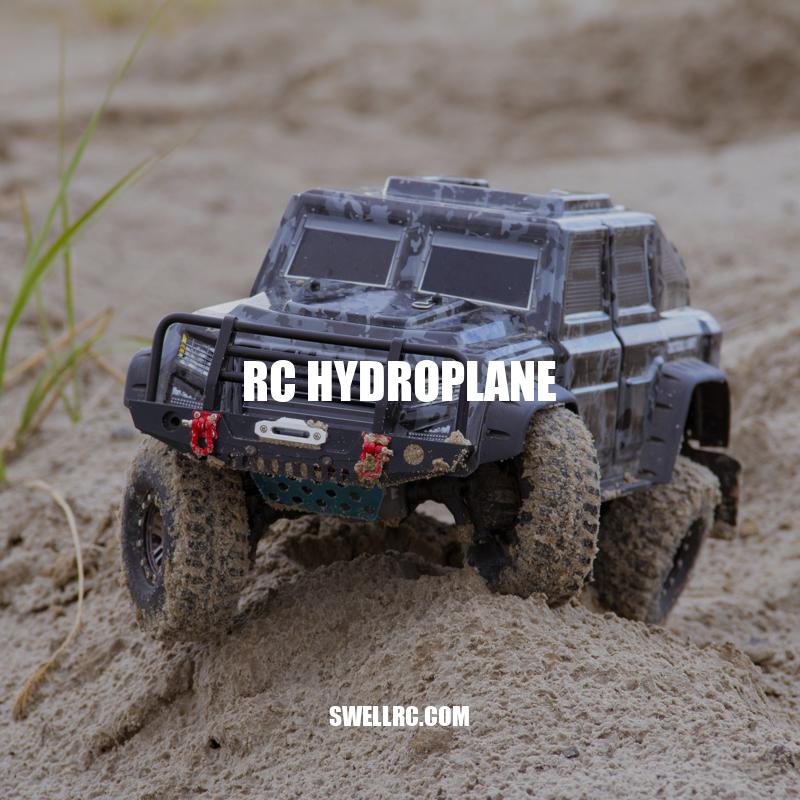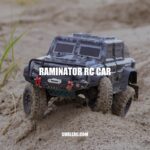RC Hydroplane Racing: A Guide to Building, Maintaining and Racing
Remote-controlled (RC) hydroplanes are a popular and thrilling sport enjoyed by many water sports enthusiasts worldwide. An RC hydroplane is a radio-controlled boat that is designed to move at high speeds on the water surface. This boat has a hull design that’s designed to lift the vessel out of the water as it moves forward. It prevents water drag, thereby enabling the boat to roll at high speeds. The hull’s V-shape plays a crucial role in stability and control over the boat at high speeds. RC hydroplanes come in different sizes, ranging from small boats that can fit in a swimming pool to big hydroplanes that race in the open water. Regardless of the size of the RC hydroplane, they all require skill and precision to operate, making it an exciting and challenging sport to participate in. In this article, we will discuss what an RC hydroplane is, its history, important components, building considerations, maintenance tips, safety precautions, and more to help you become a better RC hydroplane racing competitor.
History of RC Hydroplane
The first RC boat was built around 1898, merely two decades after the first hydroplane made an appearance. The world’s first official model powerboat race was held in 1908 on a lake in France. In the 1920s, rc hydroplanes received popularity from different countries such as the United States, United Kingdom, and Japan. The first world championship race was held in Detroit (USA) in 1949. Since then, the sport has grown globally, with more races and competitions held yearly. Below are some notable records set in the world of RC hydroplane racing:
- 59.446 mph average speed in one kilometer (USA) – the world is the fastest electric-powered hydroplane
- 200 mph water speed (USA) – fastest Nitro-powered hydroplane
- 135.4 mph water speed (France) – fastest electric-powered hydroplane over a quarter-mile
- 185.2 mph water speed (New Zealand) – fastest gas-powered hydroplane
Today, RC hydroplane racing has improved immensely, with sophisticated components and efficient designs used in boat construction.
When was the Hydroplane made?
The first hydroplane was built in 1917 by the legendary American boat builder, Christopher Columbus Smith. Hydroplanes are light and fast boats that use a combination of lift and propulsion to skim across the surface of the water.
Here are a few additional facts about the history of hydroplanes:
- The first competitive hydroplane race was held in 1946 in Detroit, Michigan.
- Hydroplanes have been used for a variety of purposes, including racing, rescue operations, and military reconnaissance.
- Today, hydroplanes remain popular in racing circuits around the world, particularly in the United States and Europe.
If you’re interested in learning more about hydroplanes, there are several websites and products that specialize in this type of boating, including the Hydroplane Racing League and the Hydroplane and Raceboat Museum in Seattle, Washington.
Key Components of RC Hydroplane
RC Hydroplanes are specially designed boats that require specific components to function well. Some of the crucial components of an RC hydroplane include:
- Body: Shaped like a traditional hydroplane’s hull, the body of the RC hydroplane houses all the components of the boat and plays a vital role in its stability in water.
- Motor: The engine is necessary for providing power to the hydroplane to move. Common engine options include nitro, electric, and gas-powered motors.
- Propeller: The propeller is responsible for powering the hydroplane through the water. It should be made from strong materials to withstand the high speed and pressure of water.
| Components | Usage |
|---|---|
| Battery | Power source for the motor and receiver |
| Rudder | To maneuver the RC hydroplane left or right |
| Receiver | Transmits signal to the servo and motor |
| Servo | Controls the rudder, enabling the steering of the hydroplane |
| Speed control | Regulates the performance and speed of the motor |
Interestingly, some RC hydroplane racers make their components, which enhances efficiency and boat performance in the water.
What do you need for a RC boat?
To start, you’ll need the following for a basic RC boat setup:
- RC boat kit or prebuilt RC boat
- 2-3 channel radio transmitter and receiver
- Battery and charger
- Speed controller
- Motor
- Propeller
- Servo
- Paint and finishing materials (optional)
If you’re looking for products to start your RC boat journey, you can check out websites like Horizon Hobby or Tower Hobbies that offer a range of RC boat products and kits.
Choosing and building an RC Hydroplane
When choosing and building an RC hydroplane, there are critical factors that you should consider to avoid any mechanical mishaps and to ensure the boat’s optimal performance. These include:
- Type of hydroplane: Select an RC hydroplane that best suits your skill level and racing experience.
- Speed: Determine the speed you’d like your RC hydroplane to reach and select components that will deliver that speed.
- Materials: Choose high-quality materials for the RC hydroplane to ensure durability and longevity.
To build an RC hydroplane, you’ll need to follow a straightforward process that involves several steps, including:
- Designing the RC hydroplane
- Gathering all the necessary components
- Assembling the frame, installing the motor, propeller, and other parts
- Painting and adding finishing touches to the RC hydroplane
You can find various RC hydroplane kits online that come with all the components and instructions required to build your hydroplane. Kits range in price from affordable to high-end, so you can choose the kit that fits within your budget. Additionally, there are several online communities and forums dedicated to RC hydroplanes where you can find helpful tips, advice, and reviews of different RC hydroplane models and components.
Maintenance of RC Hydroplane
Caring for your RC hydroplane is essential to maintain its longevity and optimal performance. Here are some tips for regular maintenance:
- Cleaning: Before and after every race, ensure to clean and dry your RC hydroplane thoroughly. This helps in preventing any buildup of dirt, debris, or water that can damage the internal components.
- Inspecting: Inspect the RC hydroplane regularly to ensure that all components are functioning correctly. Check for loose connections, broken pieces, or any damage that you need to address.
- Lubrication: Apply lubricants to the bearings and other moving parts to minimize friction and help the hydroplane move smoothly.
- Battery maintenance: Remove the battery from the RC hydroplane if it won’t be used for an extended period. This helps in prolonging the battery life.
Following regular maintenance can prevent costly repairs and replacements. In case you need to replace any component, ensure that you use high-quality parts to prevent further damage.
There are several websites and online shops where you can purchase RC hydroplane components, including motors, propellers, and batteries. Some notable brands to consider include:
- Aquacraft: This brand offers a range of RC hydroplanes, accessories, and batteries that cater to various skill levels and budgets.
- Pro Boat: This brand offers high-quality RC hydroplanes that are suitable for beginners and experienced racers.
- Traxxas: Known for their versatility and durability, Traxxas offers a range of RC hydroplanes with powerful motors and excellent performance.
RC hydroplane racing can be an exciting and challenging sport. However, it can be dangerous if adequate safety precautions are not observed. Below are some safety tips to ensure safe racing:
- Wear Safety Gear: Always wear protective gear, including a helmet, goggles, and gloves to protect your eyes, head, and hands.
- Check the Weather: Check the weather conditions before heading to the race. Avoid racing in strong wind or heavy rain as it can make controlling the hydroplane challenging.
- Know Your Limits: Practice caution when racing and stay within your skill level. Pushing your limits can lead to accidents and injuries.
- Avoid Crowded Areas: Stay clear of crowded areas, and make sure you have enough space to maneuver your hydroplane smoothly.
- Watch Out for Obstacles: Observe the race course and watch out for obstacles such as buoys, rocks, or other boats that may hinder your movement.
These safety tips can prevent accidents and injuries and make hydroplane racing more enjoyable. Remember, it’s better to be cautious than to risk your safety.
There are websites that offer guidelines and safety measures for racers and spectators alike. RC Hydroplane Racing is one such website that provides detailed information on safety, including mandatory safety equipment and requirements. It’s essential to familiarize yourself with these guidelines before competing in an event. Additionally, it’s crucial to purchase your RC hydroplane from reputable stores that provide quality products and safety instructions.
Conclusion
RC hydroplane racing is a thrilling and exciting sport that can be enjoyed by people of all ages. With careful preparation, adequate safety gear, and proper maintenance, you can ensure that your hydroplane operates smoothly and safely. Whether you’re a beginner or an experienced racer, there’s always room for improvement, and with dedication and practice, you can excel in the sport.
Remember to choose quality components and materials in building your hydroplane – it will make all the difference in the performance and durability of your boat. Stay updated with the latest guidelines in safety measures and maintain a high standard of safety at all times.
Overall, RC hydroplane racing is an engaging and exhilarating hobby that fosters competition, innovation, and teamwork. If you’re passionate about boats or speed, this sport is perfect for you. Get started today and watch your hydroplane come to life, ready for its next race. Have fun and stay safe!



